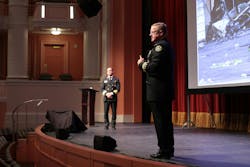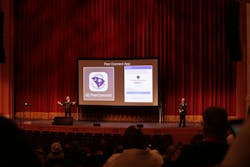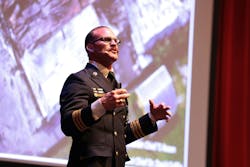FireFusion 2024: Operations, Technology Changes Since Sofa Super Store Tragedy Highlighted
The memories of June 18, 2007 — a day in history that the fire service was forced to look inside themselves and see where they must improve and not repeat history — are still as raw as they were 17 years ago.
The fire at the Sofa Super Store in Charleston, SC, started outside and spread inside, growing at an exponential rate. The firefighters responding didn't have the complete layout of the store and lacked the knowledge of their surrondings, which led to technological advancements and training changes. Then, in the blink of an eye, there were nine firefighters trapped inside the building that never made it back out.
"We realized that we were not in the fire academy anymore, and everything after this was going to be recovery," said Battalion Chief T.J. Axson.
A special session at FireFusion 2024, "Into the Ashes," was led by two firefighters who were relatively new to the Charleston Fire Department when the tragic incident happened. Assistant Chief David Griffin (author of Firehouse's Leadership Lessons column) and Axson spoke on the advances that have helped everyone in the fire service since the tragedy.
“Our passion is to make sure something like this doesn’t happen again,” said Griffin.
Axson and Griffin highlighted the technology they had access to in the Charleston Fire Department 17 years ago, including:
- A trunked radio system
- One desktop that was shared in the firehouse
- One fax machine
- A red hotline phone to submit the roster for the day
- Hand-written preplans and floor schematics
- One radio channel for everything
- Lack of technology to see proper ventilation tactics
Not to mention, there was next to no knowledge of drop ceilings and void spaces in store that played a role the fire growing, command was mobile rather than today’s stationary command and there were no mental health programs.
After the tragedy, those who survived had to go back to work like everything was normal. That took a toll on the firefighters, Axson and Griffin recalled. Now, Charleston implemented a peer connect app, SCPeerConnect that allows the firefighter to pick people you feel comfortable talking with, and with a click of a button can notify those specific people that you are in need.
“We sat there just waiting for the for the next group to come in and relieve us. We told them what had happened. We can't remember whether we got in a truck or a pickup or a truck or a car, and we drove back to the station,” said Axson.
The idea behind the FireFusion presentation was to present the audience with how the fire service has grown over the years in their advances, and to motivate those to embrace the change and to be proactive in seeking out technology. Griffin talked about normalizing deviant behavior, in the essence of when things are going well, you don’t know if they could be going better.
“One day I realized that just coming to work every third day, that's not going to do it. That's not leadership,” said Griffin. “What are you doing on the other days and at night to mentor and coach people and do this research and evolution of technology?”
Griffin and Axson showed the emerging technologies that are playing a role into today’s fire service response, along with those that peeking around the corner. All of these are implemented or being developed within the Charleston Fire Department:
- Auto aid agreements
- Consolidated dispatch center
- Mobile data terminals
- Station alerting system
- Records and learning management systems
- Command training center
- Accountability software
- Drones
- Hiring efficiency
- Recruit training
- Driver’s training
- Officer development
While there was a large emphasis on physical technology and enhancements that are being created and made, Griffin ensured that it is not just about the technology. It is about the people.
“It's not just about the technology, it's about the people pushing the technology. You must let your people that are doing their job, develop it,” said Griffin. “Our job doesn't end when we retire, it is our job to set up the next generation.”

Ryan Baker
Ryan Baker is a writer and associate editor with prior experiences in online and print production. Ryan is an associate editor for T&D World and Firehouse, while he is going to graduate school in pursuit of a master's degree in sciences of communication at University of Wisconsin-Whitewater. He recently completed a year of teaching Intro to Public Speaking at UW-Whitewater, as part of his graduate program. Ryan acquired his bachelor's degree in journalism in 2023 from UW-Whitewater, and operates currently out of Minneapolis, MN. Baker, also writes freelances for the Ultimate Frisbee Association (UFA) in his free time, while also umpiring baseball for various ages across the Twin Cities Metro Area.








